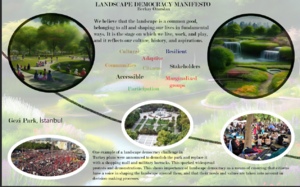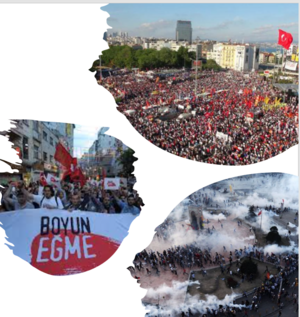Democratic Landscape Transformation 2023 - Team 7: Difference between revisions
Ola23team7 (talk | contribs) |
Ola23team7 (talk | contribs) |
||
| Line 11: | Line 11: | ||
* https://docs.google.com/presentation/d/1VXegVuBjH8LOFaTcZkVdaw4wdDrMZBMwlZHZzALPgyE/edit#slide=id.p | * https://docs.google.com/presentation/d/1VXegVuBjH8LOFaTcZkVdaw4wdDrMZBMwlZHZzALPgyE/edit#slide=id.p | ||
* '''Berkay Özarslan,Manifesto, Gezi Park, İstanbul. Link''': https://drive.google.com/file/d/1vliiu2ldQ99OPiQNjdCwKV_hOUQo9oWy/view?usp=share_link[[File:Manifesto'.png|thumb]] | * '''Berkay Özarslan,Manifesto, Gezi Park, İstanbul. Link''': https://drive.google.com/file/d/1vliiu2ldQ99OPiQNjdCwKV_hOUQo9oWy/view?usp=share_link[[File:Manifesto'.png|thumb]] | ||
* | * https://uploadnow.io/f/Wb0NhZZ | ||
* add link here | * add link here | ||
| Line 24: | Line 24: | ||
== The Role Play == | == The Role Play == | ||
Jan Gehl | |||
Danish Architect and Urban Planner | |||
Founder of Gehl Architects | |||
Author of “Life Between Buildings” | |||
Taken by team 7 as role play model for the Democratic Landscape Transformation Seminar 2023 | |||
Life Between Buildings is Jan Gehl's classic text on the importance of designing urban public space with the fundamental desires of people as guiding principles. The book describes essential elements that contribute to people's enjoyment of spaces in the public realm. These elements remain remarkably constant even as architectural styles go in and out of fashion and the character of the 'life between buildings' changes. "Google Books Description" | |||
This book will have a lasting influence on the future quality of public open spaces. By helping us better understand the larger public life of cities, Life between Buildings can only move us toward more lively and healthy public places. "Landscape Architecture Magazine" | |||
“Life Between Buildings” asks the fundamental question “What has happened to life in cities?”. It persistently investigates why life has disappeared from the cities, and it provides solutions on how to invite life back. If we want to create livable spaces we need to prioritize people, the human senses, and the human scale by planning cities in eye level.<blockquote>https://uploadnow.io/f/VxF9PQv</blockquote> | |||
== Readings, concepts and definitions == | == Readings, concepts and definitions == | ||
Revision as of 08:09, 5 July 2023
>>> Back to working group overview
>>> Back to seminar reading list
Background of your team
- Please write a few words about your team.
- Which linguistic and cultural perspectives are you representing? Which disciplinary backgrounds? Berkay Özarslan: I graduated from Ege University in Turkey with title 'Landscape Architect' in 2022 and I wanted to develop this profession further more with master degree, During my university year I attended several design workshops voluntarily. I had a chance to study in SGGW, Warsaw for 1 semester with Erasmus Programme. My aim in my professional life is to make sustainable Landscape designs that inspires people.
Your Landscape Democracy Manifestoes
Here you can add links to the manifestoes you have presented on April 26
- https://docs.google.com/presentation/d/1VXegVuBjH8LOFaTcZkVdaw4wdDrMZBMwlZHZzALPgyE/edit#slide=id.p
- Berkay Özarslan,Manifesto, Gezi Park, İstanbul. Link: https://drive.google.com/file/d/1vliiu2ldQ99OPiQNjdCwKV_hOUQo9oWy/view?usp=share_link
- https://uploadnow.io/f/Wb0NhZZ
- add link here
Examples of Landscape Activism
Berkay Özarslan, 'İstanbul Not for Sale' Movement
During a period of rapid urban development and gentrification in Turkey, early 2013s, . Many historic neighborhoods and green spaces in the city were being demolished. The government had announced plans to demolish the Gezi Park in Taksim Square and replace it with a shopping mall, which sparked a wave of protests across the country. The activists saw this as a threat to the democratic rights of citizens to participate in decision-making processes that impact their lives and their environment. •The movement was led by young designers who used their creative skills to mobilize support and raise awareness about the importance of preserving public spaces and green areas in the city. •The Istanbul Not For Sale campaign worked with urban planners and architects to develop alternative models of urban development that were more participatory and sustainable. They organized workshops and public forums where residents could share their ideas and concerns about the future of their neighborhoods •Through their efforts, the Istanbul Not For Sale campaign succeeded in raising awareness about the negative impacts of urban development and promoting alternative models of urban planning that were more participatory, sustainable, and equitable.
Link to the presentation :https://docs.google.com/presentation/d/e/2PACX-1vTudKq3v8c_pyCXWw7qKY_oIG3saTxurhjN4xrOLAT8gxL_nmF-Rz6cBT4V-GLa98oDzt9YNrp9nsuT/pub?start=false&loop=false&delayms=3000
The Role Play
Jan Gehl
Danish Architect and Urban Planner
Founder of Gehl Architects
Author of “Life Between Buildings”
Taken by team 7 as role play model for the Democratic Landscape Transformation Seminar 2023
Life Between Buildings is Jan Gehl's classic text on the importance of designing urban public space with the fundamental desires of people as guiding principles. The book describes essential elements that contribute to people's enjoyment of spaces in the public realm. These elements remain remarkably constant even as architectural styles go in and out of fashion and the character of the 'life between buildings' changes. "Google Books Description"
This book will have a lasting influence on the future quality of public open spaces. By helping us better understand the larger public life of cities, Life between Buildings can only move us toward more lively and healthy public places. "Landscape Architecture Magazine"
“Life Between Buildings” asks the fundamental question “What has happened to life in cities?”. It persistently investigates why life has disappeared from the cities, and it provides solutions on how to invite life back. If we want to create livable spaces we need to prioritize people, the human senses, and the human scale by planning cities in eye level.
Readings, concepts and definitions
- Start: April 5, 2023
- Due: July 5, 2023
Working in your group, express your personal understanding of the relation of landscape and democracy in the form of a concept map with linking words or any other diagrammatic representation. Please make your maps very visual and not just verbal. Think critically about why one map differs from another
About concept mapping
Before starting the exercise you can read this article by Joseph D. Novak & Alberto J. Cañas about Theory Underlying Concept Maps and How to Construct and Use Them. This paper gives a good explanation of how concept maps are conceived and developed.
You can use any tool you like for producing your concept map. However, since the result needs to be submitted digitally we recommend the following open source software for producing your maps:
- Cmap Tools >>> you can also work with your group on the Cmap cloud doing a shared map
- VUE - The Visual Understanding Environment
Please add your concept map(s) here
- Possible format: JPG (for wiki upload) or link to any other resource
- You may add one map per team member or an integrated one
- add as many additional materials as you need
Please finish with a short reflection
- What are the similarities and differences in your team regarding your understanding of what democratic landscape transformation is?
- In how far did the seminar lectures and readings help you to clarify this?
- What will you take home from this seminar?


